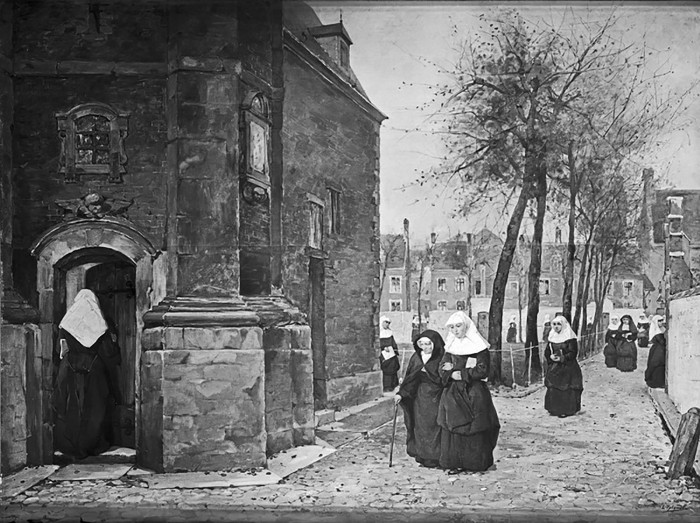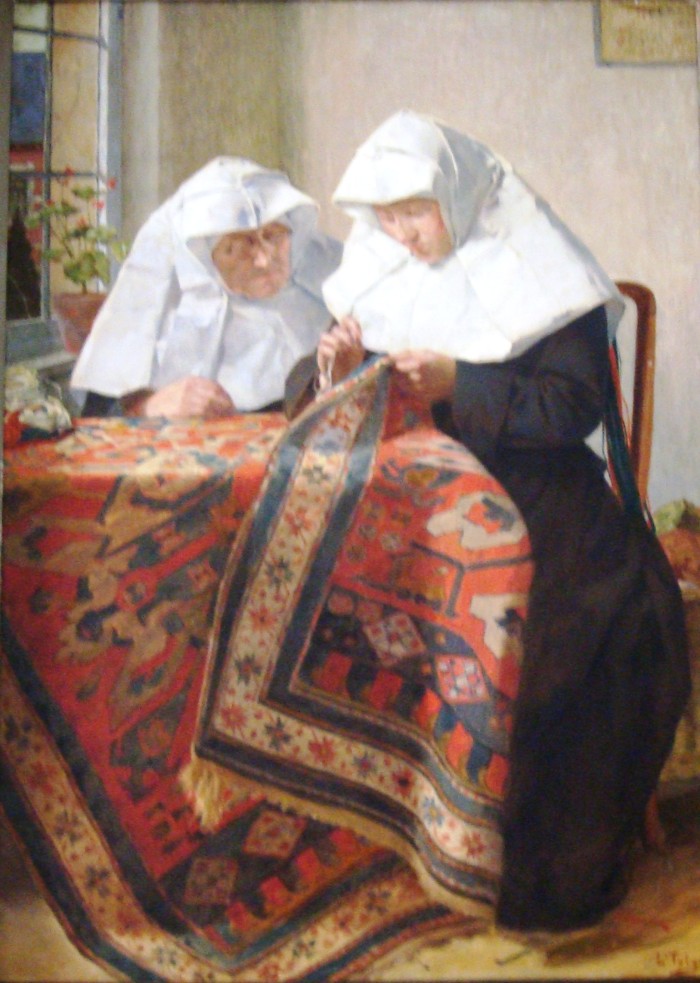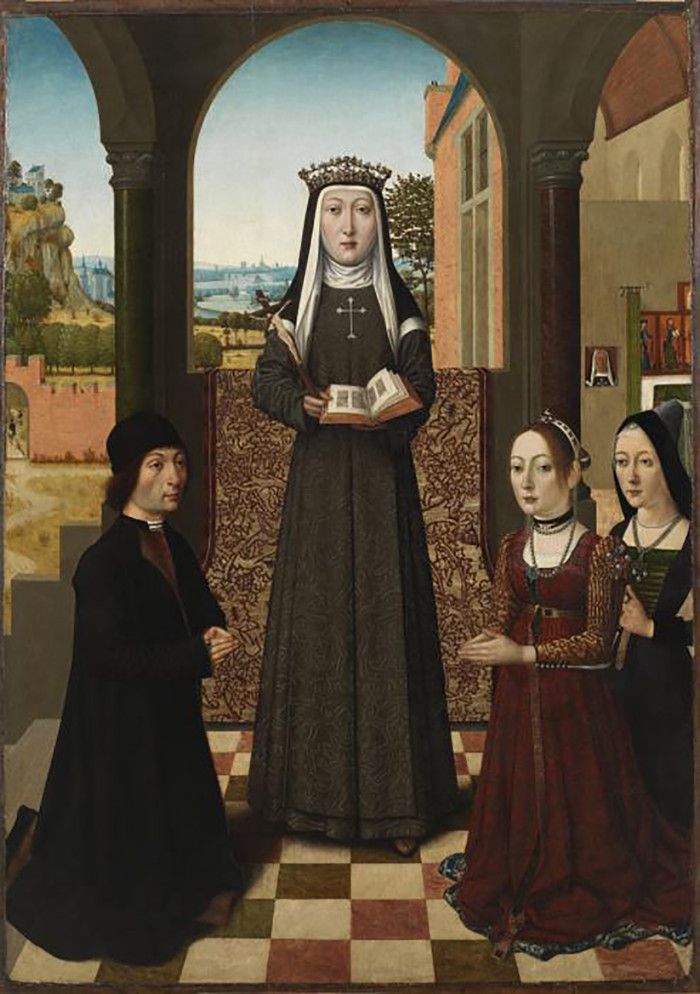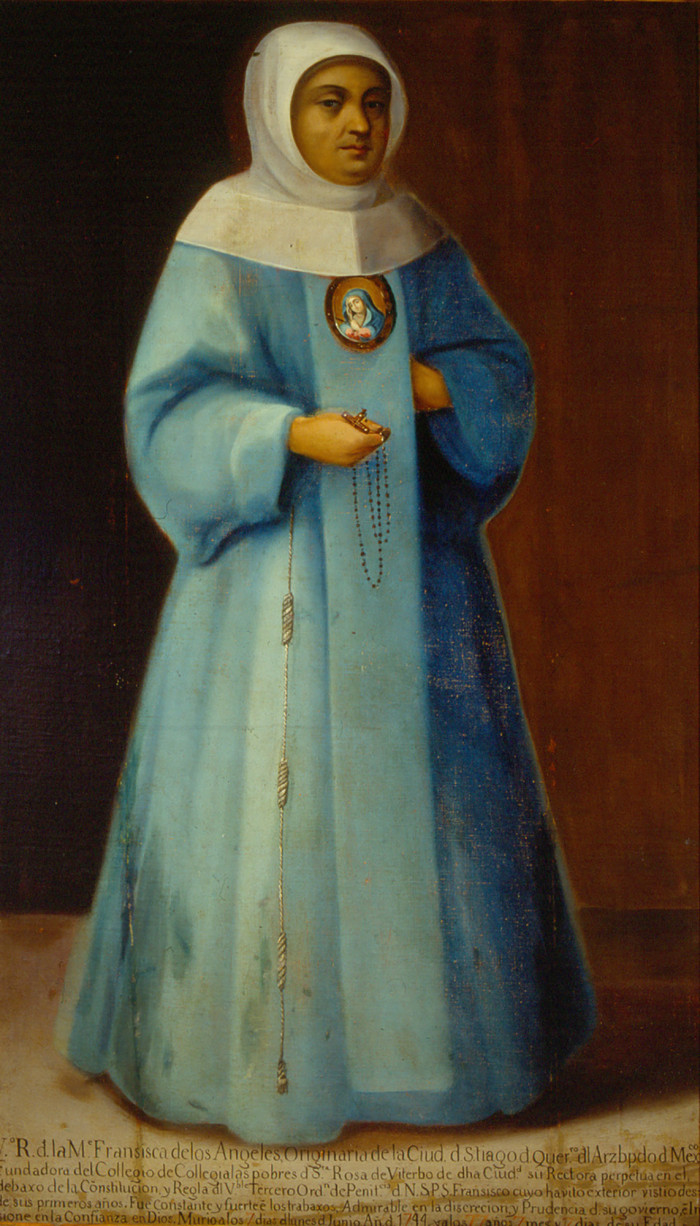
24.10.2016
Juliana Ossa traces a genealogy of Western feminine religious mysticism, focusing on Francisca de los Angeles (1674 – 1744) of Querétaro, Mexico, to observe her spiritual and intellectual practice as a space of feminine emancipation

This is the place where consciousness is no longer master, where, to its extreme confusion, it sinks into a dark night that is also fire and flames. This is the place where “she” –and in some cases he, if he follows “her” lead –speaks about the dazzling glare which comes from the source of light that has been logically repressed, about “subject” and “Other” flowing out into an embrace of fire that mingles one term into another, about contempt for form as such, about mistrust for understanding as an obstacle along the path of jouissance and mistrust for the dry desolation of reason. Also about a “burning glass”.
-Luce Irigaray, La Mysterique
In The Foundations of Mysticism (1991), Bernard McGinn presents his understanding of mysticism by describing it “as an element of Christian belief; as a process or way of life and as an attempt to express a direct consciousness of the presence of God.” [1] He suggests that if mysticism is a process or a way of life in which the ultimate goal is a particular kind of encounter with God, “everything that leads up or prepares [the mystic] for this encounter… is also mystical”[2]. The activities performed by religious people in the pursuit of a mystical life include asceticism, contemplative prayer, extreme fasting, self-flagellation, sleep deprivation, and other forms of penitence. Likewise, reading, interpreting religious texts and writing have a devotional dimension that is constitutive of the mystical life. For this reason, scholars of mysticism have provided different approaches to the role of writing in the mystical experience.
Evelyn Underhill argues that mystics write because they are “literary artists,” who successfully clothe their intense experience in symbolic language[3]. In the same light, McGinn has noted that mystical writings manage to unveil some of the most profound mysteries of the human spirit.[4] Finally, Charles M. Stang argues that since “mystical writing can serve as a spiritual exercise in the service of soliciting an encounter with the mystery of God…mystics write in order to become mystics” [5].
I consider that writing is not only a means through which the mystical experience is achieved. In many cases, writing is also an end in the mystical path. In this sense, mystics also write because they are mystics. Part of their duty as chosen vessels of God is to convey the ways in which God has been revealed to them.
The mystical experiences of Christian women became an important aspect of Western Christianity by the late middle ages. From this moment on, women began to appear as the protagonists and authors of religious texts and the number of female saints and mystics multiplied in Western Europe. Prior to the 12th Century, access to the written word was limited to those who knew Latin and knowledge of Latin was restricted to the ecclesiastical and secular elites. But with the development of a written tradition in the vernacular, access to the written word was democratized and literacy rates among men and women outside the elites increased. While mystical literature continued to be produced in Latin, especially in monastic communities, pious laywomen began to contribute to the diffusion of religious texts in the vernacular by reading and writing devotional texts.

Alongside new forms of self-expression came new forms of religious life. Over the course of the 12th Century, the Beguine movement emerged in northern Europe providing a new alternative for medieval women who were reluctant to getting married and who wanted to follow a religious life without joining a convent. Caroline Walker Bynum explains that, “the structure of the medieval family and of inheritance patterns necessitated alternatives to the role of marriage and procreation for a large portion of the population… [Moreover], in the thirteenth and fourteenth centuries the value of dowries went up sharply, making the marriage of daughters (or even endowing of a place for them in one of the traditional monasteries) sometimes prohibitively expensive.”[6] Thus, women had to explore new alternatives to live their lives.
The Beguines were pious women who continued to live in the world and supported themselves by working. They did not belong to specific religious orders and were allowed to retain private property. Although they promised to remain chaste for as long as they were beguines, they were free to get married or to join official orders at any time. Chastity, simplicity and manual labor were the key elements of beguine spirituality.[7] In southern Europe, the Franciscan and Dominican tertiaries were the beguines’ counterparts. Some of the most prominent medieval mystics like Hadewijch of Antwerp and Catherine of Siena were beguines and tertiaries. They served God by serving the poor and the sick and composed religious texts of different kinds such as visionary accounts, spiritual diaries, epistles and poems in vernacular languages.
Female religious life in Medieval Europe had its parallels in Spanish America. Scholars of medieval Christianity have agreed that one of the developments that characterized religious life in the late middle ages was the “feminization” of religious life. This implied the emergence of new religious roles for women (like the beguines and the tertiaries), their involvement in the production of religious texts and the overall improvement of religious women’s status in society. This feminization of religious life was echoed in the Counter Reformation and transferred across the Atlantic after the conquest and colonization of the New World. The foundation of convents and beatarios during the 17th and 18th Centuries, the massive mobilization of women to monastic communities and the proliferation of female writings indicate a specific female presence and sensitivity in the Catholic Church during this period[8].
Although the forms of religious expression and the styles of religious life that characterize medieval female piety had their equivalents in colonial Spanish America, most studies about Christian mysticism have ignored the connections and similarities among Christian women in different geographical and historical contexts. Further, studies that attempt to provide a universal picture of the female mystical tradition in western Christianity usually fail to mention the existence of non-European female mystics.[9] This lack of recognition of the mystical experiences of colonial women is problematic; regardless of whether mysticism is understood as an element of Christianity, as a way of life or as a phenomenon that is manifested in the human consciousness, the experiences of non-European mystics make part of the textual history of Christian female piety. Kathleen Ann Myers has noted that biographies of holy women in the New World are important “because of the new perspective they give to the role of holy people, especially women, in the new world. They form a petite histoire for Spanish America and give insight into how religious women were central to the building of America’s Christian identity.”[10]

Female mystics from the New World are ethnographers, theologians, and historians who ought to be included in the Christian mystical tradition. Their texts are anthropological documents that reveal the daily activities of religious women as well as their intellectual and emotional landscapes. They are theological treatises that describe an affective and intimate form of spirituality. They contribute to our knowledge about the diversity of forms that women have used to experience and convey their relationship with God, they enable the construction of a more holistic and inclusive picture of Christian piety and present an alternative narrative of the conquest and colonization of the New World.
When literary critics and historians began to look at mystical writings in the colonial world, they centered their attention on the experiences and writings of professed nuns, who always wrote at the command of their confessors and spiritual guides. This is perhaps because most of the evidence on this subject comes from accounts written in elite convents. Male clerics were responsible for supervising the content of devotional texts, which aimed to provide the guidelines of proper female piety, and to situate mysticism and asceticism within the framework of Christian orthodoxy.[11] The models of exemplary lives established in these narratives were diffused among the general Christian public for their imitation. Consequently, the quest for a mystical way of life was also common among laypeople. Earlier studies suggested that the religious experiences of laywomen were silent because they were usually illiterate.[12] However, recent findings have proven that pious laywomen authored texts of different styles. [13]
The life and work of Francisca de los Angeles (1674 – 1744), a pious laywoman who lived in Querétaro during the 17th and 18th Centuries, attests to the active engagement of women from different social backgrounds in different forms of religious life and their production of mystical texts in Spanish America.
Francisca de los Angeles belonged to a modest family. The events of life follow the hagiographic tradition: like Catherine of Siena and Teresa of Avila, her religious devotion was evident from a very early age. One day, while playing at the orchard, Francisca stared at the sun and saw the image of the Child Christ. From then on, He became her constant companion and taught her how to pray while discouraging her from playing with other children. At the age of nine, her spiritual life was shaped by a group of Franciscan missionaries who arrived from Spain in Querétaro in 1683 to establish a Catholic school. They crossed the viceroyalty by foot and spread throughout the land with the purpose of propagating Catholicism. Apart from evangelizing native infidels, they influenced New Spanish Christians from all social classes by preaching and practicing self-flagellation in public and wearing crosses and crowns made of spines.[14] After hearing them preach, Francisca convinced her aunt to take her to one of their masses and began confessing with them. At the age of ten, she made a vow of chastity before Jesus Christ.[15]
Francisca developed a close relationship with a group of clerics from the convent of Santa Cruz in Querétaro. They provided protection for her and her family when her father passed away in 1689 and financed the construction of four cells for them to live.[16] Alongside her mother and sister, Francisca became a Franciscan tertiary and followed a strict religious discipline.

For many years, Francisca experienced visions and mystical trances that she recounted in the letters that she wrote to her confessors from 1689 to 1736. She also founded and directed the beatario de Santa Rosa de Viterbo in Querétaro, one of the most prominent religious houses for laywomen in the region. In addition to describing the devotional practices that she engaged in and narrating her visions and raptures, her letters speak of her friendship with her spiritual mentors and her actions as the leader of a lay religious community. Upon Francisca’s death, her Franciscan mentors archived her entire correspondence, which comprises one of the earliest epistolary collections from colonial Spanish America. [17]
The experiences and writings of Francisca de los Angeles have been made available to modern readers through the work of Ellen Gunnarsdottir, a Spanish professor at the University of Iceland. Her study on Francisca de los Angeles constitutes one of the few exceptions where the writings of a colonial beata have been translated and annotated extensively. Gunnarsdottir argues that the experiences and writings of Francisca were a product of the society where she lived. High Baroque Mexico was a hybrid between the European and the indigenous, and “an open and vibrant society with a neo-medieval character”.[18] The language Francisca used in her writings followed the tradition of baroque popular spirituality, which, to maintain a popular devotion among illiterate people, emphasized the use of images over contemplation of the sacred scriptures. In Spanish America, “the inculcation of orthodoxy thorough imagery was evident in the widespread use of household altars and crucifixes as well as in the elaborate religious festivals common to cities and villages”. As a result, imagination played an important role when people engaged in mental prayer[19]. Furthermore, Francisca was a literate woman who had received a religious education. Thus, her experiences were influenced by the mystical texts that circulated in New Spain in her time[20]. An example of this is a letter that she wrote to one of her confessors, where she describes how after being in prayer for a while, she is embraced by fire and sees a precious young boy. Together, they travel to a land of infidels, and God asks Francisca to choose the souls she wants Him to save. In this vision, Francisca’s power to intercede for the souls of other people is revealed. Like the Spanish mystic Maria de Agreda, whose writings were widely read in New Spain, Francisca is able to travel to faraway lands in her raptures and convert infidels.
The case of this beata proves that in spite of not having institutional power within the Catholic Church, mysticism has provided different women with a road to sainthood and a vehicle for autonomy and self-expression. In their writings, women mystics have been able to transmit their own theological messages in a creative manner by blending the language of devotion with the language of love. Furthermore, in spite of not being allowed to preach, women’s written accounts have influenced the behavior of other people.
The stories of colonial mystics provide an alternative narrative of the conquest and colonization of the New World that focuses on the internal battles of religious women. Every action they performed was a milestone in their journey towards Catholic perfection. At the same time, every woman in Spanish America who chose to pursue a mystical life constituted a triumph for the Catholic Church in its mission to evangelize the New World. Female mystics in Spanish America were able to engage in intellectual exercises of different kinds, and to find creative ways of exercising their autonomy and authority. For them, the language of religion provided a tool to talk about their affective and intellectual worlds. As a field of study, mysticism provides a unique understanding of women’s intellectual history. For female mystics, the presence of God is equated with the experience of Love.
Notes
[1] Bernard McGinn, The Presence of God: A History of Western Christian Mysticism, vol. 1, The Foundations of Mysticism: Origins to the Fifth Century (New York: Crossroad, 1991), pp xv-xvi
[2] Ibid, xvi
[3] Charles. M Stang, “Writing,” in The Cambridge Companion to Christian Mysticism, ed. Amy Hollywood et.al (New York: Cambridge University Press, 2012) ,.252
[4] Bernard McGinn, ed., The Essential Writings of Christian Mysticism (New York: Modern Library, 2006) xiv
[5] Charles. M Stang. “Writing,” 252
[6] Caroline Walker Bynum, Holy Feast and Holy Fast, (Berkeley: University of California Press, 1987), 19
[7] Fiona Bowie, introduction to Beguine Spirituality, ed. Fiona Bowie and Oliver Davies, (New York: Crossroad, 1990), 11
[8] Asuncion Lavrin and Rosalva Loreto Lopez, Monjas y Beatas: La Escritura Femenina en la Espiritualidad Barroca Novohispana, Siglos XVII y XVIII, ed. Lavrin, and Loreto López, (Mexico: UDLA/AGN 2002), 18
[9] Two examples of this are The Essential Writings of Christian Mysticism (McGinn, 2006), and The Cambridge Companion to Christian Mysticism (Hollywood et.al. 2012). The first is an anthology of Christian Mystical writings, which does not include any writers from Spanish America. The second one is a compilation of twenty-two essays that attempts “to work against the tendency to reduce complex phenomena” (p.4), and to “insist on the various and multiple experiences of God recounted within a wide range of Christian texts” (p.5). Yet, out of the twenty-two essays in this volume, only Alison Weber’s essay on gender makes reference a study by Kathleen Myers, based on the writings of three colonial nuns. (See, Myers, The Mystic Triad, 1997)
[10] Kathleen Ann Myers, Neither Saints Nor Sinners: Writing the Lives of Women in Spanish America, (New York: Oxford University Press, 2003), 3
[11] Lavrin, Loreto Lopez, introduction to Monjas y Beatas, 24
[12] Josefina Muriel, Cultura Femenina Novohispana, 2nd Ed. (UNAM: Mexico DF, 1994), 316
[13] Brianna Leavitt-Alcántara, “Holy Women and Hagiography in Colonial Spanish America,” History Compass, 12, no. 9 (2014): 718, accessed 20/11/2014 18:10, DOI: 10.1111/hic3.12191.
[14] Ellen Gunnarsdottir, “Una Visionaria Barroca de la Provincia Mexicana: Francisca de los Angeles (1674 – 1744)” in Monjas y Beatas, 208
[15] Ellen Gunnarsdottir, Mexican Karismata, 188
[16] Ibid, 63
[17] Ellen Gunnarsdottir, Mexican Karismata: The Baroque Vocation of Francisca de los Angeles, 1674-1744, (Lincoln: University of Nebraska Press, 2004), 5
[18] Ibid, 11
[19] Ellen Gunnarsdottir, Mexican Karismata, 2
[20] Josefina Muriel has noted that “The Mystical City of God” written in the sixteenth century by the Spanish mystic Maria de Jesus de Agreda was edited in Spain seventy-two times, and one in Mexico. (Cultura Femenina Novohispana, 315)
Comments
There are no coments available.